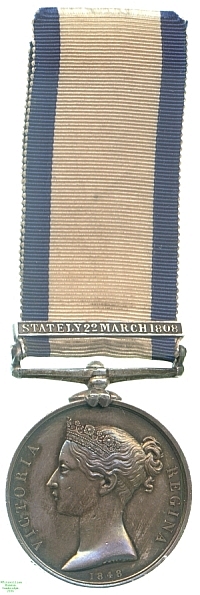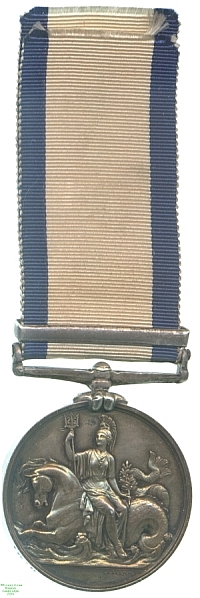
Obverse, a bust of Queen Victoria

Reverse, Britannia with a trident seated sideways on a seahorse

Obverse, a bust of Queen Victoria |

Reverse, Britannia with a trident seated sideways on a seahorse |
Just as in 1848 the extensive land campaigns of the Napoleonic Wars and the other conflicts of the pre-Victorian era were recognised by the issue of the Military General Service Medal, those serving in the Navy at the time were recognised with the Naval General Service Medal. As with the Army equivalent and the East India Company's related award, many of the battles for which the medal was awarded had been fought so long ago that few if any claimants survived.
In addition, bars were awarded for many actions whose significance and size were, despite the heroism displayed by those involved, relatively minor. The result was that many of the bars were issued in tiny numbers, with some combinations all but unique, and the medals command a very high price among collectors because of this rarity and individuality. This in turn, along with the manufacture in most cases of more bars than were eventually issued, has led to the `improvement' of many common awards where recipients' names are shared with those present at `rarer' battles. The medal also shares with the Military General Service and Army of India Medals the oddity that Queen Victoria, whose portrait they bear, was not the ruler under whom the battles for which it was awarded were fought.
By the Treaty of Tilsit of 1807 it was agreed between Emperor Napoleon I and Russia that France, whose navy had been badly reduced by the losses at the Battle of Trafalgar, could appropriate the substantial Danish naval and mercantile fleet without Russian objections. The British, when they learnt of this, understandably did object and demanded of Denmark that their fleet be sent into protective custody with the British. Danish refusal led to an undeclared British attack on and bombardment of Copenhagen until the fleet units there were surrendered in September 1807, and taken back to Britain as prizes, mostly being broken up on arrival.
Denmark, financially and navally crippled, was thus forced into a French alliance, which made the few vessels left to her prey to British ships. Thus it was that when HMS Nassau and the 64-gun third-rate HMS Stately encountered the Danish battleship Prince Christian Frederick off Grenå on 22 March 1808, they engaged and forced a surrender, but the Danish ship ran aground soon afterwards. The grounded vessel lay under Danish artillery, and could not be recovered, so the British burnt her and left. Stately's surviving crew received 27 awards of the NGSM with this bar for the encounter in 1848.
Robert Miller, part of Stately's contingent of Royal Marines, was one of those 27. His service aboard the vessel has been verified, and the Medals Roll confirms the award of this piece to him, although it gives the bar as Stately 1809--there was no such bar issued. The Roll also adds the detail that Murray was entitled to the St Domingo clasp, although he must then have been aboard a different vessel; why he did not claim the bar, or at least why it is not on the medal, cannot be told. Lester Watson purchased the medal at some point before 1928.